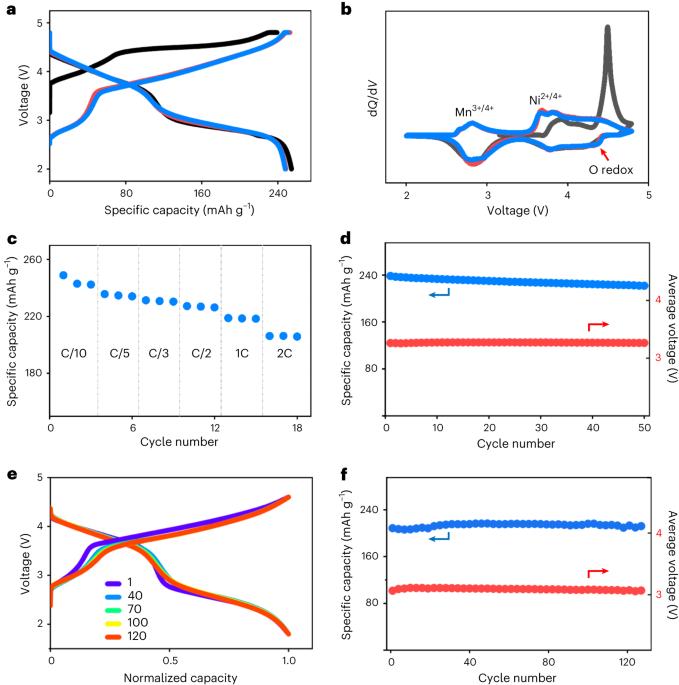具有可忽略电压衰减的富锂层状氧化物阴极
IF 60.1
1区 材料科学
Q1 ENERGY & FUELS
引用次数: 1
摘要
富含锂和锰(LMR)的层状氧化物具有高容量、低成本的特点,是下一代锂离子电池中很有前途的一类阴极。然而,由于不稳定的 Li2MnO3 蜂窝结构,在循环过程中电压会大幅衰减,这仍然是其实际应用的一个障碍。在此,我们报告了一种电压衰减可忽略不计的无钴 LMR 锂离子电池阴极。该材料具有由层状 LiTMO2 和各种堆叠的 Li2MnO3 组成的复合结构,其中 Li2MnO3 锂层中的过渡金属 (TM) 离子形成了盖帽,以加强蜂窝结构的稳定性。实验和计算结果表明,这种带帽蜂窝结构在高压循环后仍能保持稳定,并能防止 TM 迁移和氧气流失。这项研究表明,通过内部固定蜂窝结构,可以有效缓解 LMR 中长期存在的电压衰减问题,这为开发下一代高能阴极材料开辟了一条途径。富锂层状氧化物是很有前途的下一代电池阴极材料,但它们长期存在循环过程中电压衰减等问题。作者在本文中分析了电压衰减的根本原因,并提出了一种结构工程策略,以缓解无钴富锂层状氧化物的电压衰减问题。本文章由计算机程序翻译,如有差异,请以英文原文为准。

A Li-rich layered oxide cathode with negligible voltage decay
With high capacity at low cost, Li- and Mn-rich (LMR) layered oxides are a promising class of cathodes for next-generation Li-ion batteries. However, substantial voltage decay during cycling, due to the unstable Li2MnO3 honeycomb structure, is still an obstacle to their practical deployment. Here we report a Co-free LMR Li-ion battery cathode with negligible voltage decay. The material has a composite structure consisting of layered LiTMO2 and various stacked Li2MnO3 components, where transition metal (TM) ions that reside in the Li layers of Li2MnO3 form caps to strengthen the stability of the honeycomb structure. This capped-honeycomb structure is persistent after high-voltage cycling and prevents TM migration and oxygen loss as shown by experimental and computational results. This work demonstrates that the long-standing voltage decay problem in LMRs can be effectively mitigated by internally pinning the honeycomb structure, which opens an avenue to developing next-generation high-energy cathode materials. Lithium-rich layered oxides are promising cathode materials for next-generation batteries, but they suffer from long-standing problems such as voltage decay during cycling. Here the authors analyse the root cause of voltage decay and present a structure engineering strategy to mitigate the issue for a cobalt-free, lithium-rich layered oxide.
求助全文
通过发布文献求助,成功后即可免费获取论文全文。
去求助
来源期刊

Nature Energy
Energy-Energy Engineering and Power Technology
CiteScore
75.10
自引率
1.10%
发文量
193
期刊介绍:
Nature Energy is a monthly, online-only journal committed to showcasing the most impactful research on energy, covering everything from its generation and distribution to the societal implications of energy technologies and policies.
With a focus on exploring all facets of the ongoing energy discourse, Nature Energy delves into topics such as energy generation, storage, distribution, management, and the societal impacts of energy technologies and policies. Emphasizing studies that push the boundaries of knowledge and contribute to the development of next-generation solutions, the journal serves as a platform for the exchange of ideas among stakeholders at the forefront of the energy sector.
Maintaining the hallmark standards of the Nature brand, Nature Energy boasts a dedicated team of professional editors, a rigorous peer-review process, meticulous copy-editing and production, rapid publication times, and editorial independence.
In addition to original research articles, Nature Energy also publishes a range of content types, including Comments, Perspectives, Reviews, News & Views, Features, and Correspondence, covering a diverse array of disciplines relevant to the field of energy.
 求助内容:
求助内容: 应助结果提醒方式:
应助结果提醒方式:


